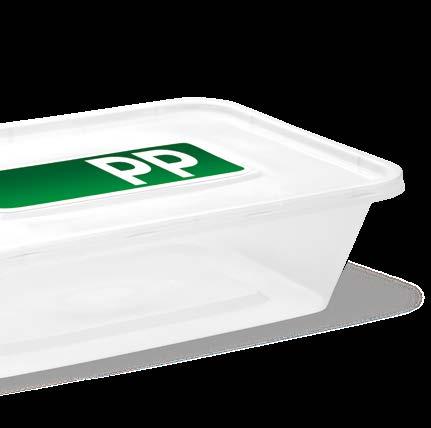
4 minute read
3.2.2 PP
DECORATION AND OTHER COMPONENTS
If the packaging is printed directly, the printing inks must at least be EuPIA-compliant and non-bleeding in order to prevent potential contamination.
Minimal printing with light or glazing colours is advantageous. If labels and sleeves are used, they should be made of the same base material as the packaging (e.g. HDPE, LDPE, MDPE, LLDPE).
In-mould labels made of PE can also be used. However, a high degree of printing can have a negative effect here, as the label is recycled together with the base material.
If the decoration is made of a material other than PE, a maximum of 50% of the packaging surface should be covered so as not to hinder the correct sorting of the base material8 .
The batch coding and the indication of the best-before date should best be carried out in the form of an embossing or laser marking.
Wet-strength paper labels are preferable to conventional paper labels as they do not release fibres that contaminate the recyclate. Labels and sleeves made of PP, OPP and PET can be used if necessary, provided that a maximum of 50% of the packaging surface is covered8 .
In addition, all labels made of a material other than PE or PP should be water-washable, in order to ensure separation from the PE fraction and no adhesive residue should remain.
The batch coding and indication of the best-before date can, if necessary, also be done by minimal direct printing with other coding systems (e.g. ink-jet), provided that food-grade inks are used.
Labels made of other materials that are not water-washable can negatively affect the sorting or recyclate quality of the PE fraction.
PVC sleeves and labels should generally be avoided, even if they are water-washable.
Large-area decorations (> 50% of the packaging surface) and full-surface sleeves made of a material other than PE can impair the sorting of the packaging 8. Adhesive materials containing metal or aluminium (with a layer thickness of > 5 µm) can lead to unwanted sorting into the metal fraction.
Bleeding inks should be avoided.
Closures are ideally made of the same base material as the tray/cup (e.g. HDPE, LDPE, LLDPE, MDPE).
If sealing foils are used, they must be easy to remove without leaving any residue.
Flexible closures made of PE and PP plastic laminates are compatible with the PE fraction in small quantities.
PP closures can lead to contamination in larger quantities9 .
Closures made of other materials such as PET, PET-G, PS and PLA should be avoided, as these can lead to secondary contamination of the PE fraction.
Metals, thermosets, EPS, PVC as well as seals and silicones that cannot be completely removed are considered interfering substances.
Sealing foils that are not completely removable and contain an aluminium component (layer thickness > 5µm) can impair the sorting.
CLOSURE SYSTEM

MATERIAL DECORATION

CLOSURE




MATERIAL
In the best case PP trays and cups are as unpigmented as possible (transparent) or white and consist of PP monomaterial without any barrier.
If barrier requirements exist, a silica (SiOx), alumina (Al2O3) barrier or carbon plasma coating 7 (for colored bottles only) can be used, as these do not significantly affect the quality of the recyclate.
A multi-layer composite material can be used if necessary, if this is made up of different PP types (e.g. OPP, BOPP).
Multilayer composites with small amounts of PE are recyclable.9
Additives can be added if the density of the base material remains < 1 g/cm3 and thus the density grading is not impaired. If necessary, an EVOH barrier layer can be used, provided that applicable limit values are complied with.10
The metallisation (aluminium vapour deposition) of the base material can cause problems in sorting under certain circumstances. In addition, this can lead to a deterioration of the recyclate quality (grey colouration).
A material compound with PS, PVC, PLA, PET and PET-G should be avoided, as this contaminates the PP fraction.
The use of density-altering additives (e.g. talc, CaCO3) as well as foaming agents for chemical expansion, which lead to an increase in density to ≥ 1 g/cm³, can cause problems in sorting, as the material-specific classification is no longer possible.
Barrier layers or the composite with PVDC, PA and EVOH10 (if applicable limits are exceeded) represent interfering substances in the recycling of the material, as they contaminate the recyclate.
The addition of oxo-degradable additives damages the recyclate and is banned throughout the EU from 2021 due to the Single-Use Plastics Directive.
Dark colouring can have a negative effect on the recyclate quality. Carbon black -based colours can prevent sorting.










